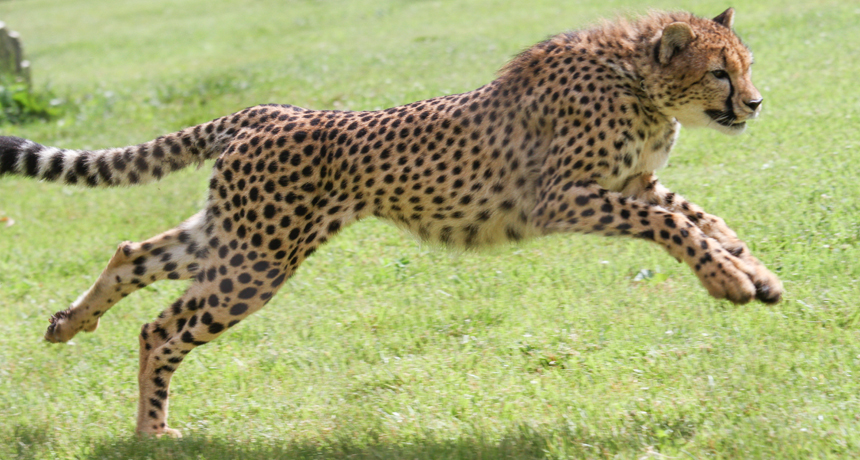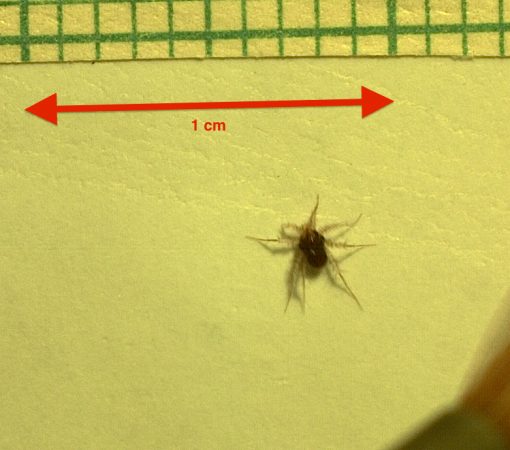Move over cheetah: Mite sets new speed record
This California critter would outrun all other land animals, if you scaled them down to its size

Cheetahs have a reputation for being the fastest land animals. That’s not true. If the cats were scaled down to the size of a mite, the tiny arachnids would be faster.
Mark Dumont/Flickr
SAN DIEGO — Tough luck, tiger beetle. A tiny mite found in Southern California has just smashed your land-speed record for animals.
At first glance, this mite may not seem so fast. It’s only about the size of a sesame seed. Yet that would be one fast seed: At top speed it can zoom at about 30 centimeters (11.8 inches) per second.
At its fastest, this mite can cover a distance 322 times its body length in a single second. The previous land-speed record holder, an Australian tiger beetle, moves at a more leisurely 171 body-lengths per second. And the supposedly ultra-fast cheetah? It can manage short sprints at 93 kilometers (58 miles) per hour. That’s fast, but the big cat covers a mere 16 body lengths or so per second.
If the mite were scaled to the size of a human, its speed would be equivalent to a person running at 2,092 kilometers (1,300 miles) per hour. That would mean it could easily outrun a moving car, high-speed train — or even a commercial jet.
Jonathan Wright and Samuel Rubin reported the mite’s land-speed record last week at the Experimental Biology meeting in San Diego, Calif. The species, Paratarsotomus macropalpis (PARE-uh-tar-SO-toh-miss MAC-ro-PAL-piss), resembled blowing bits of dust when Wright first spotted them. The biologist works at Pomona College in Claremont, Calif., about an hour’s drive from downtown Los Angeles. Rubin is a student studying physics at Pitzer College, also in Claremont.

Rubin collected some last summer for this study. He used a tool called an aspirator to suck up and capture the tiny creatures without choking on them. “The hose you breathe in through has a mesh filter on the bottom, inside the chamber,” he explains. That way “you don’t inhale mites.”
The researchers then turned the mites into film stars. In the lab, they recorded the animals on high-speed video to zero in on how the mites move their legs and turn. They also filmed some mites in the field to catch them barreling along at top speed.
From the footage, the researchers were able to calculate the mites’ record-breaking speed. They also saw that the mites could accelerate and slow down rapidly. A mite can even manage sharp changes in direction — sometimes pivoting on its third leg to make especially tight turns.
Some mites are predators. Owen Seeman says there are even species that are as fierce as lions in the savannah. Those mites stab their prey with their mouthparts, ripping open their prey’s belly. Then they vomit digestive enzymes into the prey’s carcass and suck their victim dry. (Only its shell is left behind.) Seeman works at the Queensland Museum in South Brisbane, Australia. As an acarologist, he studies mites and ticks.
While there’s still little known about the eating habits of P. macropalpis, the researchers say the need to chase down prey may explain why it evolved such high speeds. But this tiny critter might not top the podium for long. “I wouldn’t be surprised if there are other mites that are faster,” says Wright.
Jürgen Otto has studied closely related mites in Australia. He says the Californian mite’s speed record is interesting. But even more importantly, its swift propulsion “probably raises questions about muscle functioning and physiology.” Physiology is the study of how an organism functions, from the cellular level up to full-body motion. Otto is an acarologist with the Australian Government Department of Agriculture, based in Sydney.
Another mite in the same family, called Anystis baccarum, can be found living in many places around the world. These tiny red animals are often seen running atop picnic tables and other surfaces. Like their even-speedier California cousins, these mites, too, “move at an unbelievably fast rate, with their little red legs whirring like the Roadrunner,” says Seeman.
The Californian mites can “move faster than their skeletal muscles should be able to work,” observes Wright, of Pomona College. He says that finding out more about the wee animal’s biomechanics — how its body propels it — could help engineers develop ultra-fast new robots and other devices.
But speed isn’t the animal’s only fascinating trait. “The mites are also very small and light,” says Rubin. He’s the student who led much of the fieldwork. Mimicking the mites’ technique “could be used to engineer smaller and lighter technologies,” he says. Rubin suspects mites could inspire not only robots that can work in small spaces but even the development of new prosthetic body parts.
Being a speed demon is not this mite’s only super-power. It’s also a heat freak. Most animals can’t survive temperatures above 50° Celsius (122° Fahrenheit). But the Californian mite zips along even when the heat hits 60 °C (140 °F). The researchers want to understand how this mite continues to function in such brutal conditions.
Interestingly, the mite’s close Australian relatives also love it hot, notes Otto. At room temperature, those mites dig into the sand, lay on their backs and stop moving. Only when he lowered a lamp to warm up the sand did they perk up — all the way up.
In fact, Otto observed, the mites seem to move at only two speeds: a racing pace or full stop. “They don’t seem to have medium gear,” says Otto. “They are incredibly fast or virtually immobile, never in-between.”
The tiny mite Paratarsotomus macropalpis covers many body lengths in a single second.
Credit: Samuel Rubin (W.M. Keck Science Center, Pitzer College), Dr. J.C. Wright Laboratory (Department of Biology, Pomona College), The Claremont University Consortium, Claremont, CA.
Power Words
arachnid A group of invertebrate animals that includes spiders, scorpions, mites and ticks. Many have silk or poison glands.
acarology The study of mites and ticks, which are types of arachnids. Scientists who work in this field are called acarologists.
biomechanics The study of how living things move, especially of the forces exerted by muscles and gravity on the skeletal structure.
engineering The field of research that uses math and science to solve practical problems.
evolve To change gradually over generations, or a long period of time. In living organisms, the evolution usually involves random changes to genes that will then be passed along to an individual’s offspring. These can lead to new traits, such as altered coloration, new susceptibility to disease or protection from it, or different shaped features (such as legs, antennae, toes or internal organs).
locomotion The ability to move from place to place.
mite An invertebrate belonging to the broad group of animals known as arachnids, which also includespiders and ticks. None of these are insects, although like insects they belong to the larger umbrella group, called arthropods (named for their members’ segmented legs).
physiology The branch of biology that deals with the everyday functions of living organisms and how their parts function.
predator (adjective: predatory) A creature that preys on other animals for most or all of its food.
prosthesis An artificial device that replaces a missing body part. Such a prosthetic limb, for example, would replace parts of an arm or leg. These replacement parts usually substitute for tissues missing due to injury, disease or birth defects.
skeletal muscle Muscles that help an animal move and whose movements can be directed voluntarily. (The heart, also a muscle, moves involuntarily.)







